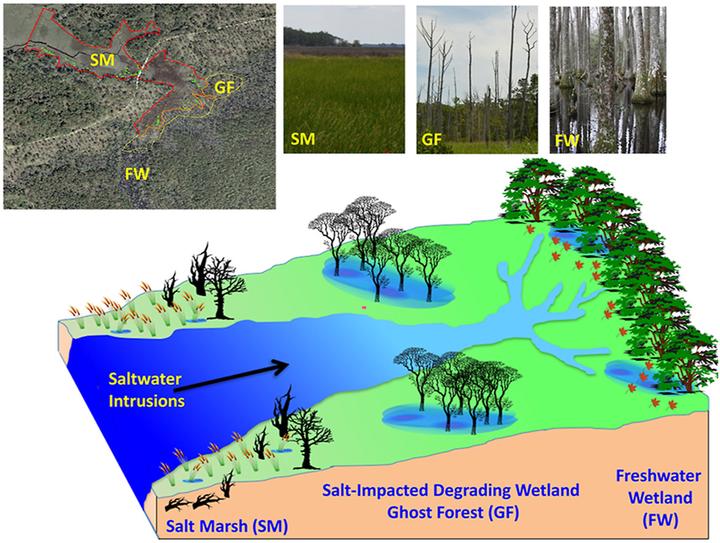Soil & Environmental Health paper on ghost forest biogeochemistry

(March 17, 2023) Just published: new collaborative paper by Chen et al. detailing the unique biogeochemistry of South Carolina ghost forests that experience increased saltwater intrusion associated with sea level rise, appearing in the inaugural issue of Soil & Environmental Health.
“Unique biogeochemical characteristics in coastal ghost forests – The transition from freshwater forested wetland to salt marsh under the influences of sea level rise”, by Huan Chen, Alexander Rücker, Yina Liu, David Miller, Jia-Ning Dai, Jun-Jian Wang, Dennis Suhre, Li-Jung Kuo, William Conner, Barbara Campbell, Robert Rhew, and Alex Chow. ARTICLE HERE
Abstract
Seawater intrusion by rising sea levels has created large areas of ghost forests along low-lying coastal wetlands in the southeastern USA, but more information is needed to better understand its soil biogeochemistry. Here, we characterized several soil and environmental parameters, including tree litterfall, surface and soil porewater quality, emissions of greenhouse gases, and microbial communities along a forest-to-marsh transect, including a freshwater forested wetland, a salt-impacted degraded ghost forest, and a salt marsh in Winyah Bay, SC, USA. General water quality parameters such as electrical conductivity, dissolved oxygen, temperature and aboveground productivity showed distinct trends along the freshwater forested wetland → degraded ghost forest → salt marsh transect, whereas there were no obvious trends in soil biogeochemical parameters. Concentrations of dissolved organic carbon (DOC) in the degraded ghost forest were generally similar to the freshwater forested wetland, but on average were higher than those in the salt marsh. More labile molecular features observed through Fourier transform ion cyclotron resonance mass spectrometry indicated an increase in the DOC biodegradability along the forest-to-marsh transect. Greater DOC biodegradability in the degraded ghost forest was observed and confirmed through its generation of the highest average electrical currents from sediment microbial fuel cells. The lowest CH4 and CO2 fluxes, but the highest degradable DOC, were observed in the degraded ghost forest, suggesting that lateral C export is important in this wetland. Moreover, the degraded ghost forest was dominated by a unique microbial community, including high abundance of Woesearchaeia, which enables carbon metabolism via symbiotic and/or fermentation-based lifestyles. Our study illustrates a ghost forest with very different characteristics compared to its parental freshwater forested wetland and its transitioned salt marsh. Data obtained from the two endmember ecosystems along the salinity gradient transect were not useful in predicting the unique biogeochemical processes in the degraded ghost forest.
Thanks to the National Science Foundation(grants EAR-1529927 and EAR-1530375) for financial support.
Figure: Schematic showing the impact of saline water inputs to the coastal ecosystems. SM = salt marsh, GF = salt-impacted ghost forest, FW = freshwater wetland